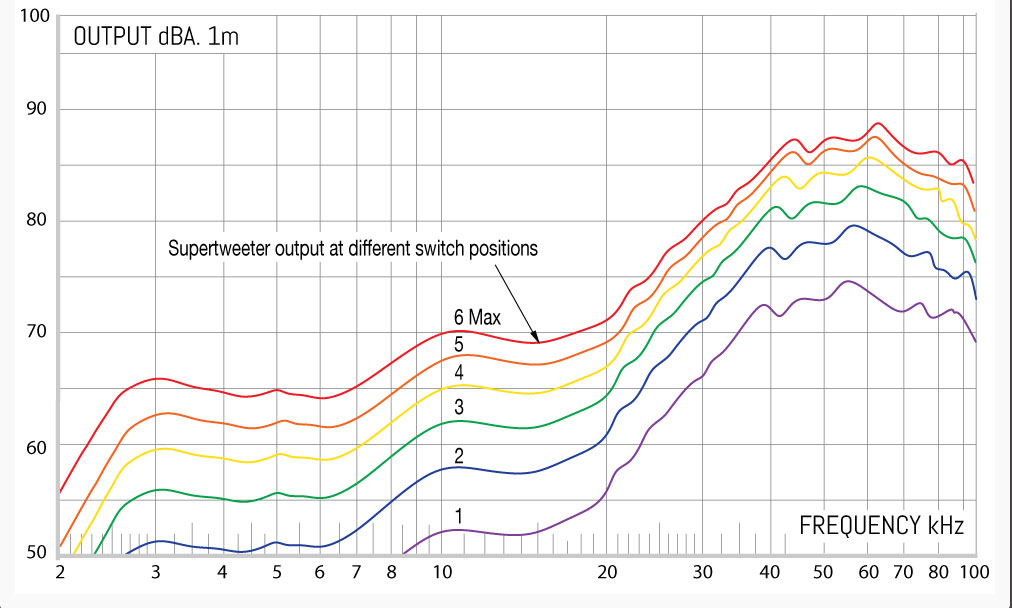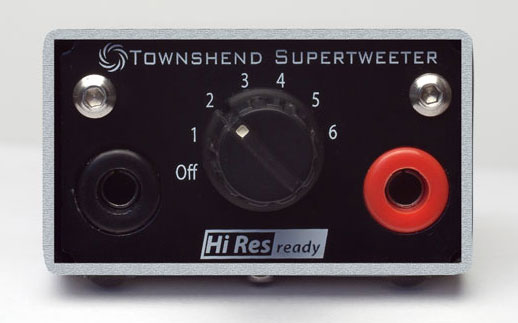I recently was introduced to a superb but very expensive add-on product known as a “super tweeter” designed and manufactured by Kan Sound Lab in Japan. I was not even familiar with this type of transducer or what it purports to do, and was quite surprised when it was first inserted into my main system. The experience caused me to do more research into the theory and history of super tweeters. One thing that became evident from my research is that, like main speakers, ST manufacturers employ different designs. However, most STs have some things in common. The most evident is that many (if not most) are ribbon tweeters. The composition of the ribbon, the frequency extension at the top end, and the crossover points are what most obviously differ in the specs for these STs.
The Townshend Maximum
As my next step I ordered a pair of Townshend Maximum super tweeters to see if the effects of the Kan ST would be replicated. As you will see, STs are a real thing, but with somewhat differing sonic effects, and I will try to parse that out for you.
The Townshend Maximum is quite small, uses an aluminum ribbon tweeter, and incorporates extremely powerful magnets that literally cause the ST to “stick” to metal. It’s delivered price (you can order it directly from Townshend) was $1,000, which at the exchange rate at the time was a great bargain. It can be ordered in silver or black (I got silver) and comes with a short speaker cable intended to connect to the terminals of the main speaker. I ordered a longer cable, as I connected the Townshend Maximum directly to my amp (the terminals on my Vivid speakers are a hassle to access).
I placed the Maximums on adjustable DJ stands next to and on the inner side of each of my Vivids, right at tweeter height. This was necessary as the Vivids don’t have a flat top that can accommodate placement of the Maximum. In most cases, where speakers have a flat top, the Maximums will simply be placed on top of the speaker, flush with the speaker’s front face. Very simple.
The Townshend Maximum control has six settings that are illustrated on the graph above. For me, “less is more,” and I settled on setting #2. Setting #3 was very close, but just a bit too much on several recordings.
It’s important to note the very different design philosophies that apply to the Maximum vs the Kan STs. Even at its lowest crossover setting, the Kan doesn’t kick in until 11 kHz, and you can also choose 19kHz and 23kHz (I reviewed it using the 19 kHz setting), while the Townshend Maximum begins to blend in at 6 kHz (though this also varies depending upon the setting you choose). This can be verified by putting your ear right up to each ST. My conscious hearing can no longer discern 19 kHz signals, so I heard nothing when I did this with the Kan. However, with the Townshend Maximum I could hear a very faint signal. To be clear, this did not in any way reduce the very positive effects of the Maximum on my system (I couldn’t hear anything after moving 6-12 inches away from the Townshend).
One of the reasons I chose the Townshend Maximum as the next ST to evaluate is that its frequency range extends to 90 kHz. Several others drop out in the 50-60 kHz range (the Kan extends to 100 kHz). My Vivid G1s already extend to 44 kHz, so I wanted to make sure that I wasn’t adding just a bit of high frequency extension; I wanted to get as close to 100 kHz as possible, or beyond.
Listening
The Townshend Super Tweeters took some time to break in — not very much, but enough so that the user should reserve judgement until at least 50 hours of playing time. Initially I thought the Townshend created a bit of a “hotter” presentation at the top end, but this disappeared with break-in. In particular, I found that running the Glide Tone, Pink Noise and White Noise tracks on the Ayre Acoustics Irrational But Efficacious disc on repeat for two hours was beneficial.
As was the case when listening to the Kan, inserting the Townshend Maximum super tweeters into my system immediately created the sensation of a more authentic “live” experience. Being a bit more descriptive, the Maximum immediately expanded the vertical dispersion of the soundstage, similar to many electrostatic speakers. Even though the transducers in my Vivid G1s have a very wide radiating pattern and create a wide sweet spot for a flexible listening position, I can nonetheless hear a degradation in the musical picture when I stand up from the prime (seated) position. The Townshend really minimizes the difference, thus actually creating an improved listening experience when several people are standing up in my dedicated listening room. This has never been much of a concern for me in the past, as the room is rarely used as a general gathering place for guests. However, since making use of super tweeters, I’ve realized that music sounds better even when it’s background for people standing and chatting in the room. Anyone whose main speakers have narrow dispersion should benefit greatly from adding the Townshends (or comparable STs).
The Townshend Maximums also added a much greater sense of space. This sense of space affected all dimensions: the space between performers; the space above, in front ,and behind the performers; and the layering of the performers. The chorus in Steely Dan’s Babylon Sisters really popped, just like you would expect to hear it in a good intimate music venue. Similarly, acapella recordings really took on a “you-are-there” feeling. A great example is The Nylons’ One Size Fits All. Every performer has his place, but the vocals nonetheless blend seamlessly.
The other ST effects that I previously experienced with the Kan ST — faster response, smoother top end, and more defined bass and mids — were also present, just not as obviously as with the Kan. However, this should not be taken as a negative. Adding the Townshends was like upgrading my Vivid G1s without the extra expense or hassle of selling them and buying/installing/breaking in new speakers. It’s just that it’s not quite as big of an upgrade as the Kan. By analogy, you can buy a really fast and nimble race car for $90,000, but if you want to complete a lap 1.1 seconds faster, you’ll likely need to spend $250,000+. If you have top notch speakers and amplification and want to see (hear?) something better, the Townshend Maximums may very well be your most cost-effective option. For example, owners of $20k speakers may need to sell them for $12k and spend $25-30k on new speakers. You may very well be able to get the same improvements for $1k. In that case, the Maximum Super Tweeter is a bargain.
Conclusion
Since my evaluation of the Maximum ST in my main system I’ve had the opportunity to try it in my secondary system: B&W SCM1 (basically an 805) plus dual NHT powered subwoofers.The improvements described above were readily discernible in that system, too, despite non-optimal placement of the speakers and subs. I concluded that, regardless of which ST I decide on for my main system, the Townshend is going to stay because it improves a wide range of systems. Definitely recommended.
POSTSCRIPT
Since reviewing the Townshend Maximum and the Kan I have identified some other STs available on the market and plan to continue my investigations into this fascinating component category. In particular, I’ve identified a company, TakeT, that makes a product called TAKET-LIVE. It uses an omnidirectional piezo-electric driver and claims to have the benefits of other STs, but with enhanced dimensionality. Stay tuned.
Copy editor: Dan Rubin
- (Page 1 of 1)









Oh please!! 90Khz!! You can’t hear above 20khz as a new born. If you are using a digital system it will have filters way before 90Khz..probably around 24kHz..
Unless you vertically align the tweeters with your system tweeter you are causing more problems than you are “solving”.
Massively over priced particularly when compared with the plethora of ribbon/amt tweeters available at a fraction of the price.
Hearing and perception are two different things. The frequency, being reproduced, may not be heard but can be felt (such as infrasonic waves) and provide a tactile quality above what you hear. And live music, in particular, with cymbals, have overtones that are way above 20khz. And you wonder why live music is hard to replicate when you cannot replicate the overtones to proper levels necessary for perception. I had ST in the past and although my system was primitive, the effect was unmistakable and it took beryllium tweeters, properly driven, to given any thought to remove the STs (which at the time were cheap, Realistic STs). I am going back simply because the added air, crispness and detail are something no speaker or equalizer can replicate, and if so, at what cost. NO eq can compare.
Why I cant hear any signal from Townsend connected directly to my speakers?
Also you mentioned that you connected the Townshend to your AMP (Power Amp)?
My Focals Sopra 2’s have a slanted top end. Will the tweeters slide off them?